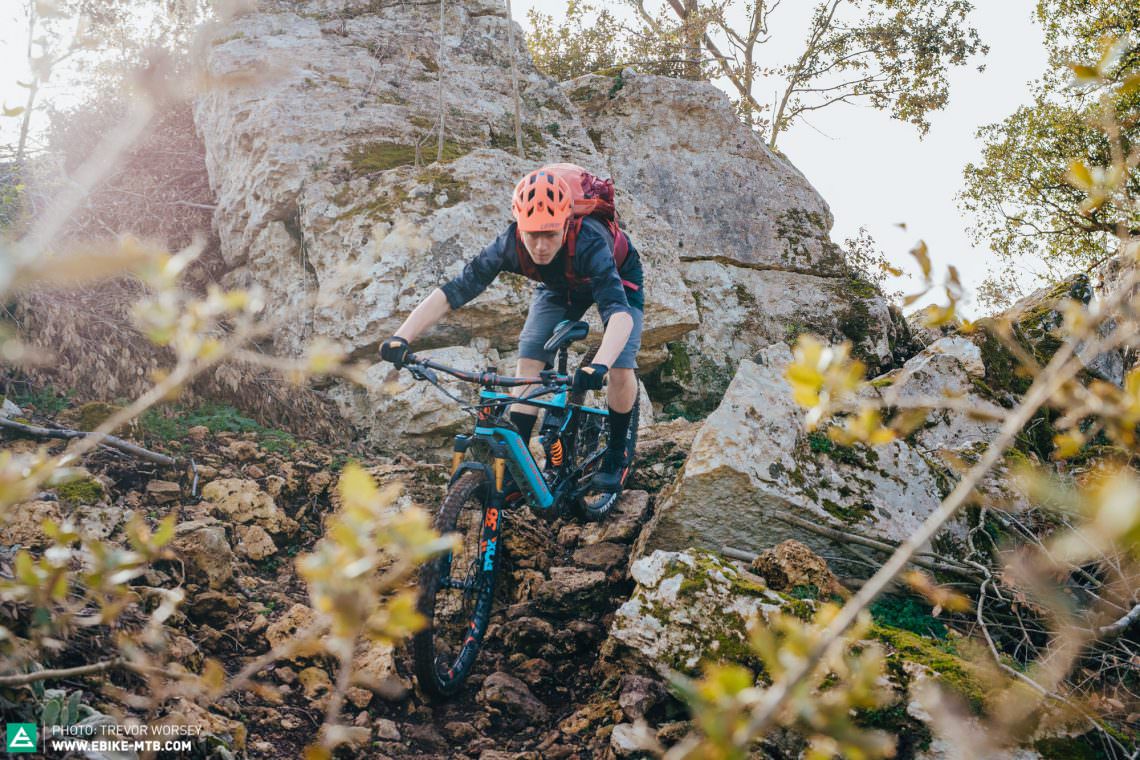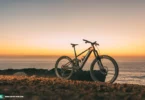Just standing there, the Mondraker Level RR looks like anything other than the roughest tracks will bore it. The frame, the build, and the geometry – it’s radical. But can you still have fun on normal trails with a bike like this?
For more information on the group test head to: The best eMTB you can buy

Mondraker has revolutionised the geometry of mountain bikes. With their Forward Geometry, the Spaniards were the driving force behind the trend of making front triangles longer and combining them with shorter stems and rear ends. They are implementing the same concept on their eMTBs. However, there is a limit to how short they can make the rear linkage due to the design of the motor. The Level RR is powered by a Bosch Performance CX and a 500 Wh-PowerTube battery and for the rest of the build, Mondraker has erred on the side of durability and functionality.
On the Mondraker Level RR, there is only one direction – straight ahead. Corners, on the other hand, are not one of this bike’s strengths.


The FOX 36 Factory fork offers 170mm travel and the 160 mm rear travel is controlled by a DHX2 coil shock. Providing tons of grip, you’ve got super tough, but also heavy, downhill casing MAXXIS Minion tires and powerful SRAM CODE RSC brakes to keep your speed in check. The robustly specced 29er weighs a whopping 25.29 kg, making it the second heaviest bike in the test field, just behind the Haibike.

Mondraker Level RR in Detail
Fork FOX 36 Factory GRIP2 160 mm
Rear shock FOX FLOAT Factory DPX2 155 mm
Motor/Battery Bosch Performance CX /PowerTube 500 Wh
Drivetrain SRAM EX1
Brakes SRAM CODE RSC 200/200 mm
Seat post FOX Factory Transfer 150 mm
Stem ONOFF Stoic FG 30 mm
Handlebar ONOFF Stoic Carbon 780 mm
Wheels DT Swiss HX1501 SPLINE ONE
Tires MAXXIS Minion DHF 29×2.5″ / DHRII 29×2.4″

The clean edges and lines of the Mondraker Level RR frame are pleasant to look at. You’ll be hard-pressed to find such a futuristic aluminium frame elsewhere.

Unfortunately, there is a limit to how far you can insert the dropper post into the seat tube. Riders with short legs should take a closer look at this before buying.

Going downhill, there is nothing to silence the chain as it slaps the chainstay.

Unfortunately, the geometry concept of Mondraker’s mountain bikes doesn’t work so well here due to the long chainstays inherent to an eMTB. The result is a super sluggish bike.
Geometry of the Mondraker Level RR
| Size | S | M | L | XL |
|---|---|---|---|---|
| Seat tube | 380 mm | 420 mm | 470 mm | 500 mm |
| Top tube | 613 mm | 642 mm | 665 mm | 688 mm |
| Head tube | 100 mm | 120 mm | 140 mm | 150 mm |
| Head angle | 65° | 65° | 65° | 65° |
| Seat angle | 74° | 74° | 74° | 74° |
| Chainstay | 490 mm | 490 mm | 490 mm | 490 mm |
| BB Height | 15 mm | 15 mm | 15 mm | 15 mm |
| Wheelbase | 1,254 mm | 1,288 mm | 1,316 mm | 1,340 mm |
| Reach | 433 mm | 462 mm | 479 mm | 498 mm |
| Stack | 608 mm | 627 mm | 645 mm | 655 mm |
Mondraker Level RR in Review

Despite the enormous length of the Mondraker Level RR, the seating position on the bike is nicely centred and very comfortable. Neither too stretched, nor too upright – just right. The Bosch motor is as powerful as usual, but with the bike’s weight and the plush suspension, the Mondraker is about 1 – 2 km/h slower than a comparable bike of this class. It’s a good thing that the SRAM EX1 drivetrain has such a large gear range, but the big gear jumps still divide the eMTB world.

If you’re after maximum climbing performance, you won’t find it here, but if you point the bike downwards, the Level RR starts to feel much more in its element. You’ll be hard pushed to find anything steep or demanding enough for this bike. It absolutely shines on rough high-speed descents – just sit back, hold on and let it go. However, as soon as you hit a corner, you’ll have to work hard to get the bike around it. Due to the long wheelbase and its heft, the bike requires a strong rider. On top of that, the rear suspension is extremely plush and offers little support, making fast direction changes particularly difficult. Once you’ve picked a line, the Mondraker is reluctant to go anywhere else. Tight sections are it’s handicap, making you feel like you’re trying to do u-turn with an 18-wheeler on narrow city streets.
Riding Characteristics
4Agility
- sluggish
- playful
Stability
- nervous
- stable
Handling
- demanding
- balanced
Riding fun
- boring
- lively
Motor feeling
- digital
- natural
Motor power
- weak
- strong
Value for money
- poor
- top
Conclusion
The Mondraker Level RR overshoots the target. With its extreme geometry, it only makes sense on super fast and challenging trails. In day-to-day riding, it’s held back by a lack of support from the rear suspension and its hefty weight. Manoeuvring the bike requires a lot of effort from the rider and we can’t recommend it for tight, winding trails. If this is the bike you want, you’ll be best served with a smaller size than you’d usually ride.
Tops
- beautiful design
- a need for speed
- high-end spec
Flops
- very cumbersome
- the rear suspension lacks support
- rattling chain
- expensive
- limited seat post insertion
For more information head to: mondraker.com

For more information on the group test head to: The best eMTB you can buy
All Bikes in Test
Canyon Spectral:ON 9.0 | Focus JAM² 9.8 DRIFTER | GHOST HYBRIDE SL AMR X S 7.7+ LC | Giant Trance E+ 0 Pro | Haibike XDURO AllMtn 8.0 FLYON | Husqvarna HC 9.0 | Intense Tazer | Lapierre eZesty AM LTD Ultimate | MERIDA eONE-SIXTY 900E | Mondraker Level RR | Scott Genius eRIDE 900 TUNED | Specialized S-Works Turbo Levo FSR | Thömus Lightrider E1 | Trek Powerfly LT 9.9
This article is from E-MOUNTAINBIKE issue #016
E-MOUNTAINBIKE Magazine is published in a digital app format in both English and German. Download the app for iOS or Android to read all articles on your tablet or smartphone. 100% free!

"The mountain hut is the destination, not the trails" – rides mainly on gravel paths and flowy singletrack, comfort plays a crucial role.↩
The focus is on riding fun. Riding skills: from beginner to experienced – the range extends from flowy singletracks to demanding technical trails.↩
A rider with very good bike control – rides on demanding and challenging technical trails, uphill as well as downhill.↩
The rating used for riding characteristics refers to the bikes in the group test and the current state of development of eMTBs. The best bikes managed to blend supposedly opposite riding characteristics, feeling both lively and stable at the same time. The handling describes the balance of the bike on downhill sections. The information regarding motor-power refers to the ride-feeling in the overall context of the bike and not exclusively to the motor – that’s why the same motor can present different values.↩
Did you enjoy this article? If so, we would be stoked if you decide to support us with a monthly contribution. By becoming a supporter of E-MOUNTAINBIKE, you will help secure a sustainable future for high-quality cycling journalism. Click here to learn more.
Words: Photos: Trev Worsey











